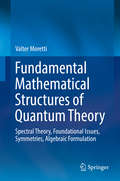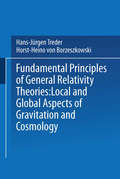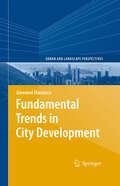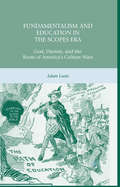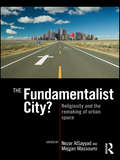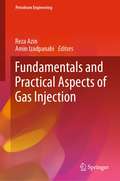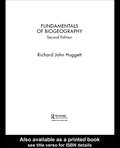- Table View
- List View
Fundamental Mass Transfer Concepts in Engineering Applications
by Ismail TosunFundamental Mass Transfer Concepts in Engineering Applications provides the basic principles of mass transfer to upper undergraduate and graduate students from different disciplines. This book outlines foundational material and equips students with sufficient mathematical skills to tackle various engineering problems with confidence. It covers mass transfer in both binary and multicomponent systems and integrates the use of Mathcad® for solving problems. This textbook is an ideal resource for a one-semester course. Key Features The concepts are explained with the utmost clarity in simple and elegant language Presents theory followed by a variety of practical, fully-worked example problems Includes a summary of the mathematics necessary for mass transfer calculations in an appendix Provides ancillary Mathcad® subroutines Includes end-of-chapter problems and a solutions manual for adopting instructors
Fundamental Math and Physics for Scientists and Engineers
by David Yevick Hannah YevickProvides a concise overview of the core undergraduate physics and applied mathematics curriculum for students and practitioners of science and engineering Fundamental Math and Physics for Scientists and Engineers summarizes college and university level physics together with the mathematics frequently encountered in engineering and physics calculations. The presentation provides straightforward, coherent explanations of underlying concepts emphasizing essential formulas, derivations, examples, and computer programs. Content that should be thoroughly mastered and memorized is clearly identified while unnecessary technical details are omitted. Fundamental Math and Physics for Scientists and Engineers is an ideal resource for undergraduate science and engineering students and practitioners, students reviewing for the GRE and graduate-level comprehensive exams, and general readers seeking to improve their comprehension of undergraduate physics. Covers topics frequently encountered in undergraduate physics, in particular those appearing in the Physics GRE subject examination Reviews relevant areas of undergraduate applied mathematics, with an overview chapter on scientific programming Provides simple, concise explanations and illustrations of underlying concepts Succinct yet comprehensive, Fundamental Math and Physics for Scientists and Engineers constitutes a reference for science and engineering students, practitioners and non-practitioners alike.
Fundamental Math and Physics for Scientists and Engineers
by David Yevick Hannah YevickProvides a concise overview of the core undergraduate physics and applied mathematics curriculum for students and practitioners of science and engineering Fundamental Math and Physics for Scientists and Engineers summarizes college and university level physics together with the mathematics frequently encountered in engineering and physics calculations. The presentation provides straightforward, coherent explanations of underlying concepts emphasizing essential formulas, derivations, examples, and computer programs. Content that should be thoroughly mastered and memorized is clearly identified while unnecessary technical details are omitted. Fundamental Math and Physics for Scientists and Engineers is an ideal resource for undergraduate science and engineering students and practitioners, students reviewing for the GRE and graduate-level comprehensive exams, and general readers seeking to improve their comprehension of undergraduate physics. Covers topics frequently encountered in undergraduate physics, in particular those appearing in the Physics GRE subject examination Reviews relevant areas of undergraduate applied mathematics, with an overview chapter on scientific programming Provides simple, concise explanations and illustrations of underlying concepts Succinct yet comprehensive, Fundamental Math and Physics for Scientists and Engineers constitutes a reference for science and engineering students, practitioners and non-practitioners alike.
Fundamental Mathematical Concepts for Machine Learning in Science
by Umberto MichelucciThis book is for individuals with a scientific background who aspire to apply machine learning within various natural science disciplines—such as physics, chemistry, biology, medicine, psychology and many more. It elucidates core mathematical concepts in an accessible and straightforward manner, maintaining rigorous mathematical integrity. For readers more versed in mathematics, the book includes advanced sections that are not prerequisites for the initial reading. It ensures concepts are clearly defined and theorems are proven where it's pertinent. Machine learning transcends the mere implementation and training of algorithms; it encompasses the broader challenges of constructing robust datasets, model validation, addressing imbalanced datasets, and fine-tuning hyperparameters. These topics are thoroughly examined within the text, along with the theoretical foundations underlying these methods. Rather than concentrating on particular algorithms this book focuses on the comprehensive concepts and theories essential for their application. It stands as an indispensable resource for any scientist keen on integrating machine learning effectively into their research. Numerous texts delve into the technical execution of machine learning algorithms, often overlooking the foundational concepts vital for fully grasping these methods. This leads to a gap in using these algorithms effectively across diverse disciplines. For instance, a firm grasp of calculus is imperative to comprehend the training processes of algorithms and neural networks, while linear algebra is essential for the application and efficient training of various algorithms, including neural networks. Absent a solid mathematical base, machine learning applications may be, at best, cursory, or at worst, fundamentally flawed. This book lays the foundation for a comprehensive understanding of machine learning algorithms and approaches.
Fundamental Mathematical Structures of Quantum Theory: Spectral Theory, Foundational Issues, Symmetries, Algebraic Formulation
by Valter MorettiThis textbook presents in a concise and self-contained way the advanced fundamental mathematical structures in quantum theory. It is based on lectures prepared for a 6 months course for MSc students. The reader is introduced to the beautiful interconnection between logic, lattice theory, general probability theory, and general spectral theory including the basic theory of von Neumann algebras and of the algebraic formulation, naturally arising in the study of the mathematical machinery of quantum theories. Some general results concerning hidden-variable interpretations of QM such as Gleason's and the Kochen-Specker theorems and the related notions of realism and non-contextuality are carefully discussed. This is done also in relation with the famous Bell (BCHSH) inequality concerning local causality.Written in a didactic style, this book includes many examples and solved exercises.The work is organized as follows. Chapter 1 reviews some elementary facts and properties of quantum systems. Chapter 2 and 3 present the main results of spectral analysis in complex Hilbert spaces. Chapter 4 introduces the point of view of the orthomodular lattices' theory. Quantum theory form this perspective turns out to the probability measure theory on the non-Boolean lattice of elementary observables and Gleason's theorem characterizes all these measures. Chapter 5 deals with some philosophical and interpretative aspects of quantum theory like hidden-variable formulations of QM. The Kochen-Specker theorem and its implications are analyzed also in relation BCHSH inequality, entanglement, realism, locality, and non-contextuality. Chapter 6 focuses on the algebra of observables also in the presence of superselection rules introducing the notion of von Neumann algebra. Chapter 7 offers the idea of (groups of) quantum symmetry, in particular, illustrated in terms of Wigner and Kadison theorems. Chapter 8 deals with the elementary ideas and results of the so called algebraic formulation of quantum theories in terms of both *-algebras and C*-algebras.This book should appeal to a dual readership: on one hand mathematicians that wish to acquire the tools that unlock the physical aspects of quantum theories; on the other physicists eager to solidify their understanding of the mathematical scaffolding of quantum theories.
Fundamental Physics and Physics Education Research (Springer Proceedings In Physics Ser. #145)
by Burra G. Sidharth Jesús Carnicer Murillo Marisa Michelini Carmen PereaThis book highlights selected contributions presented at the 15th annual international symposium Frontiers of Fundamental Physics (FFP15), with the aim of informing readers about the most important recent advances in fundamental physics and physics education research. The FFP series offers a platform for physicists from around the world to present their latest theories and findings. The latest symposium was held in Orihuela, Spain and covered diverse fields of research, including gravitation, astronomy and astrophysics, physics of complex systems, high-energy physics, and mathematical physics. Considerable attention was also paid to physics education research, teacher education in physics, and the popularization of physics. In a knowledge-based society, research into fundamental physics plays a vital role in both the advancement of human knowledge and the development of new technologies. Presenting valuable new peer-reviewed contributions submitted from 15 countries, this book will appeal to a broad audience of scholars and researchers.
Fundamental Principles of Environmental Physics
by Abel Rodrigues Raul Albuquerque Sardinha Gabriel PitaThis book is an interdisciplinary and accessible guide to environmental physics. It allows readers to gain a more complete understanding of physical process and their interaction with ecological ones underpin important environmental issues.The book covers a wide range of topics within environmental physics, including:• natural and anthropogenic canopies, including forests, urban or wavy terrains;• the fundamentals of heat transfer;• atmospheric flow dynamics;• global carbon budget;• climate change; and• the relevance of biochar as a global carbon sink.Including solved exercises, numerous illustrations and tables, as well as an entire chapter focused on applications, book is of interest to researchers, students and industrial engineers alike.
Fundamental Principles of General Relativity Theories: Local and Global Aspects of Gravitation and Cosmology
by H. TrederThe present monograph is not a self-contained introductory text. Instead it presupposes to a large extent that the reader is not only thoroughly familiar with the special theory of relativity, but that he or she has studied the standard aspects of the general theory, as weIl. Starting from local and global formulations of the principlcs of inertia and relativity, we discuss the microscopic ancl telcscopic aspects of gravitation. Our central goal has been to demonstrate that the foundations of gravitational theory laid by Newton and Einstein imply questions on thc relation betwecn the micro- and macrocosm. The discussions surrounding these physical points can be rather weH understood without an elaborate mathcmatical formalism. All the same, we have attempted to make the main theme of our presentation accessible also to readers outside the circle of pundits by including two appendixes of a largely instructional nature. Appendix A gives a brief review of the basic concepts of four-dimensional spaces, for the convenience of readers who need 9 Preface such a recapitulation, while Appendix B deals with the more exotic notions of tetrad theory, which admittedly stands in wider need of elucidation. Both appendixes are meant in any event to serve the useful purpose of establishing our notation and collecting formulas for easy reference in the main body of the book. The general reader may accordingly find it helpful first to peruse one or both of the appendixes before turning to the Introduction and Chapter 1. H. -j.
Fundamental Problematic Issues in Turbulence (Trends in Mathematics)
by Albert Gyr Wolfgang Kinzelbach Arkady TsinoberA collection of contributions on a variety of mathematical, physical and engineering subjects related to turbulence. Topics include mathematical issues, control and related problems, observational aspects, two- and quasi-two-dimensional flows, basic aspects of turbulence modeling, statistical issues and passive scalars.
Fundamental Problems in Quantum Physics (Fundamental Theories of Physics #73)
by M. Ferrero Alwyn Van Der MerweFor many physicists quantum theory contains strong conceptual difficulties, while for others the apparent conclusions about the reality of our physical world and the ways in which we discover that reality remain philosophically unacceptable. This book focuses on recent theoretical and experimental developments in the foundations of quantum physics, including topics such as the puzzles and paradoxes which appear when general relativity and quantum mechanics are combined; the emergence of classical properties from quantum mechanics; stochastic electrodynamics; EPR experiments and Bell's Theorem; the consistent histories approach and the problem of datum uniqueness in quantum mechanics; non-local measurements and teleportation of quantum states; quantum non-demolition measurements in optics and matter wave properties observed by neutron, electron and atomic interferometry. Audience: This volume is intended for graduate students of physics and those interested in the foundations of quantum theory.
Fundamental Problems of Mesoscopic Physics: Interactions and Decoherence (NATO Science Series II: Mathematics, Physics and Chemistry #154)
by Igor V. Lerner Boris L. Altshuler Yuval GefenMesoscopic physics deals with effects at submicron and nanoscales where the conventional wisdom of macroscopic averaging is no longer applicable. A wide variety of new devices have recently evolved, all extremely promising for major novel directions in technology, including carbon nanotubes, ballistic quantum dots, hybrid mesoscopic junctions made of different type of normal, superconducting and ferromagnetic materials. This, in turn, demands a profound understanding of fundamental physical phenomena on mesoscopic scales. As a result, the forefront of fundamental research in condensed matter has been moved to the areas where the interplay between electron-electron interactions and quantum interference of phase-coherent electrons scattered by impurities and/or boundaries is the key to such understanding. An understanding of decoherence as well as other effects of the interactions is crucial for developing future electronic, photonic and spintronic devices, including the element base for quantum computation.
Fundamental Tests of Physics with Optically Trapped Microspheres (Springer Theses)
by Tongcang LiFundamental Tests of Physics with Optically Trapped Microspheres details experiments on studying the Brownian motion of an optically trapped microsphere with ultrahigh resolution and the cooling of its motion towards the quantum ground state. Glass microspheres were trapped in water, air, and vacuum with optical tweezers; and a detection system that can monitor the position of a trapped microsphere with Angstrom spatial resolution and microsecond temporal resolution was developed to study the Brownian motion of a trapped microsphere in air over a wide range of pressures. The instantaneous velocity of a Brownian particle, in particular, was studied for the very first time, and the results provide direct verification of the Maxwell-Boltzmann velocity distribution and the energy equipartition theorem for a Brownian particle. For short time scales, the ballistic regime of Brownian motion is observed, in contrast to the usual diffusive regime. In vacuum, active feedback is used to cool the center-of-mass motion of an optically trapped microsphere from room temperature to a minimum temperature of about 1.5 mK. This is an important step toward studying the quantum behaviors of a macroscopic particle trapped in vacuum.
Fundamental Theories in Physics (Studies in the Natural Sciences #5)
by Stephan MintzThis volume includes the papers presented during the high energy session of the first Orbis Scientiae held by the Center for Theo retical Studies, University of Miami. The Orbis met from January 7th to 12th, 1974 for the purpose of allowing scientists in various dis ciplines to acquaint each other with frontier problems of their respective disciplines. This Orbis Scientiae was the first of a new series of annual gatherings which have replaced the Coral Gables Conferences. These new meetings will include, in addition to physics, the main stay of the Coral Gables Conferences, other sciences and will allow scientists in the various disciplines represented to exchange views with each other as well as among them selves. The high energy sessions of the Orbis were devoted primarily to fundamental theories which attempt to unify a number of interactions in physics such as the electromagnetic and gravi tational forces, the electromagnetic and weak forces, or indeed all of the known interactions. Papers were also invited on other topics of cur rent interest in high energy physics and astro physics and they form part of this volume. v PREFACE This volume is not subdivided but the first half is devoted to fundamental theories and the second half to other subjects of current interest. The last paper, on stellar evolution, was presented at the Sixth Annual J. Robert Oppenheimer Memorial Prize Ceremonies by the recipient, Professor Edwin E. Salpeter of Cornell University.
Fundamental Trends in City Development (Urban and Landscape Perspectives #1)
by Giovanni MacioccoThe Reinvented City reflects on externity, the principal feature of a reinvented city. Three basic trends of the city are investigated; "discomposed", "generic" and "segregated" phenomena with the loss of the city as a space of social interaction and communication. Important questions are posed: What is the true public sphere in contemporary societies? What is the contemporary public space corresponding to it? In what way can the city project construct contemporary public space?
Fundamentalism and Education in the Scopes Era: God, Darwin, and the Roots of America’s Culture Wars
by A. LaatsThis book takes a new look at one of the most contentious periods in American history. The battles over schools that surrounded the famous Scopes "monkey" trial in 1925 were about much more than evolution. Fundamentalists fought to maintain cultural control of education. As this book reveals for the first time, the successes and the failures of these fundamentalist campaigns transformed both the fundamentalist movement and the nature of education in America. In turn, those transformations determined many of the positions of the "culture wars" that raged throughout the twentieth century.
The Fundamentalist City?: Religiosity and the Remaking of Urban Space
by Nezar AlSayyadThe relationship between urbanism and fundamentalism is a very complex one. This book explores how the dynamics of different forms of religious fundamentalisms are produced, represented, and practiced in the city. It attempts to establish a relationship between two important phenomena: the historic transition of the majority of the world’s population from a rural to an urban existence; and the robust resurgence of religion as a major force in the shaping of contemporary life in many parts of the world. Employing a transnational interrogation anchored in specific geographic regions, the contributors to this volume explore the intellectual and practical challenges posed by fundamentalist groups, movements, and organizations. They focus on how certain ultra religious practices of Christianity, Hinduism, Islam, and Judaism have contributed to the remaking of global urban space. Their work suggests that it is a grave oversimplification to view religious orthodoxies or doctrines as the main cause of urban terrorism or violence. Instead they argue that such phenomena should be understood as a particular manifestation of modernity’s struggles. Nezar AlSayyad and Mejgan Massoumi’s book provides fascinating reading for those interested in religion and the city, with thought provoking pieces from experts in anthropology, geography sociology, religious studies, and urban studies.
The Fundamentalist City?: Religiosity and the Remaking of Urban Space
by Nezar AlSayyad Mejgan MassoumiThe relationship between urbanism and fundamentalism is a very complex one. This book explores how the dynamics of different forms of religious fundamentalisms are produced, represented, and practiced in the city. It attempts to establish a relationship between two important phenomena: the historic transition of the majority of the world’s population from a rural to an urban existence; and the robust resurgence of religion as a major force in the shaping of contemporary life in many parts of the world. Employing a transnational interrogation anchored in specific geographic regions, the contributors to this volume explore the intellectual and practical challenges posed by fundamentalist groups, movements, and organizations. They focus on how certain ultra religious practices of Christianity, Hinduism, Islam, and Judaism have contributed to the remaking of global urban space. Their work suggests that it is a grave oversimplification to view religious orthodoxies or doctrines as the main cause of urban terrorism or violence. Instead they argue that such phenomena should be understood as a particular manifestation of modernity’s struggles. Nezar AlSayyad and Mejgan Massoumi’s book provides fascinating reading for those interested in religion and the city, with thought provoking pieces from experts in anthropology, geography sociology, religious studies, and urban studies.
Fundamentals and Frontiers of the Josephson Effect (Springer Series in Materials Science #286)
by Francesco TafuriThis book provides a comprehensive and up-to-date description of the Josephson effect, a topic of never-ending interest in both fundamental and applied physics. In this volume, world-renowned experts present the unique aspects of the physics of the Josephson effect, resulting from the use of new materials, of hybrid architectures and from the possibility of realizing nanoscale junctions. These new experimental capabilities lead to systems where novel coherent phenomena and transport processes emerge. All this is of great relevance and impact, especially when combined with the didactic approach of the book. The reader will benefit from a general and modern view of coherent phenomena in weakly-coupled superconductors on a macroscopic scale. Topics that have been only recently discussed in specialized papers and in short reviews are described here for the first time and organized in a general framework. An important section of the book is also devoted to applications, with focus on long-term, future applications. In addition to a significant number of illustrations, the book includes numerous tables for comparative studies on technical aspects.
Fundamentals and Practical Aspects of Gas Injection (Petroleum Engineering)
by Reza Azin Amin IzadpanahiThis book covers different aspects of gas injection, from the classic pressure maintenance operation to enhanced oil recovery (EOR), underground gas storage (UGS), and carbon capture and storage (CCS). The authors detail the unique characteristics and specific criteria of each application, including: material balance equationsphase behaviourreservoir engineeringwell designoperating aspectssurface facilitiesenvironmental issues Examples, data, and simulation codes are provided to enable the reader to gain an in-depth understanding of these applications. Fundamentals and Practical Aspects of Gas Injection will be of use to practising engineers in the fields of reservoir engineering, and enhanced oil recovery. It will also be of interest to researchers, academics, and graduate students working in the field of petroleum engineering.
Fundamentals of Air Sampling
by Gregory D. WightThere is a growing need for environmental measurement personnel who possess a solid understanding of the techniques of air pollutant sampling. This essential book explains the fundamentals of air sampling, develops the theory of gas measurement, and presents several "how-to" examples of calibration and use of air and gas sampling devices. Other topics covered range from the basics of pressure measurement and units conversion to specific discussions regarding the use of a Volatile Organic Sampling Train or a SUMMA-polished canister sampling system.
Fundamentals of Air Sampling
by Gregory D. WightThere is a growing need for environmental measurement personnel who possess a solid understanding of the techniques of air pollutant sampling. This essential book explains the fundamentals of air sampling, develops the theory of gas measurement, and presents several "how-to" examples of calibration and use of air and gas sampling devices. Other topics covered range from the basics of pressure measurement and units conversion to specific discussions regarding the use of a Volatile Organic Sampling Train or a SUMMA-polished canister sampling system.
The Fundamentals of Atomic and Molecular Physics (Undergraduate Lecture Notes in Physics)
by Robert L BrooksThe Fundamentals of Atomic and Molecular Physics is intended as an introduction to the field for advanced undergraduates who have taken quantum mechanics. Each chapter builds upon the previous, using the same tools and methods throughout. As the students progress through the book, their ability to use these tools will steadily increase, along with their confidence in their efficacy. The book treats the two-electron atom as the simplest example of the many-electron atom—as opposed to using techniques that are not applicable to many-electron atoms—so that it is unnecessary to develop additional equations when turning to multielectron atoms, such as carbon. External fields are treated using both perturbation theory and direct diagonalization and spontaneous emission is developed from first principles. Only diatomic molecules are considered with the hydrogen molecular ion and neutral molecule treated in some detail. This comprehensive coverage of the quantum mechanics of complex atoms and simple diatomic molecules, developed from the very basic components, is extremely useful for students considering graduate studies in any area of physics.
Fundamentals of Biogeography
by Richard John HuggettFundamentals of Biogeography presents an accessible, engaging and comprehensive introduction to biogeography, explaining the ecology, geography, history and conservation of animals and plants. Starting with an outline of how species arise, disperse, diversify and become extinct, the book examines: how environmental factors (climate, substrate, topography, and disturbance) influence animals and plants; investigates how populations grow, interact and survive; how communities form and change; and explores the connections between biogeography and conservation.The second edition has been extensively revised and expanded throughout to cover new topics and revisit themes from the first edition in more depth. Illustrated throughout with informative diagrams and attractive photos and including guides to further reading, chapter summaries and an extensive glossary of key terms, Fundamentals of Biogeography clearly explains key concepts in the history, geography and ecology of life systems. In doing so, it tackles some of the most topical and controversial environmental and ethical concerns including species over-exploitation, the impacts of global warming, habitat fragmentation, biodiversity loss and ecosystem restoration.



